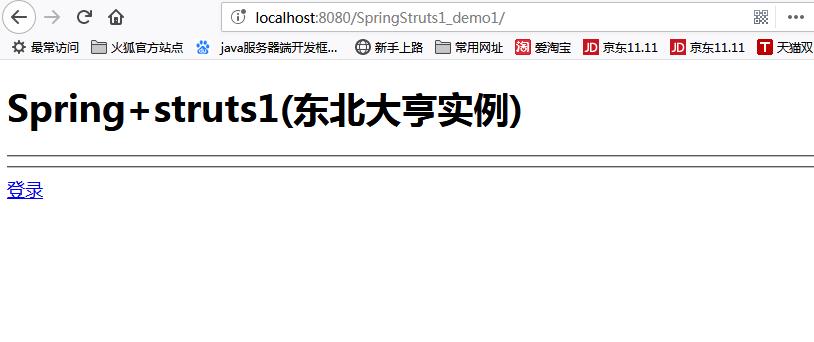spring+struts1
Posted 东北大亨
tags:
篇首语:本文由小常识网(cha138.com)小编为大家整理,主要介绍了spring+struts1相关的知识,希望对你有一定的参考价值。
概括及介绍:
集成原理:在Action 中获得BeanFactory,通过BeanFactory取得业务逻辑对象
本例采用:JDK1.8,tomcat7.0.9
技术点:spring与strut1集成方案例子介绍
集成原理:在Action 中获得BeanFactory,通过BeanFactory取得业务逻辑对象 1、spring和struts1的依赖包管理 * struts1 -- 拷贝struts1和jstl的依赖包 -- 在web.xml文件中配置 ActionServlet -- 提供 struts-config.xml 文件 -- 提供国际化支持,提供缺省国际化资源文件 * spring -- 拷贝spring相关依赖包 -- 提供spring的配置文件 2、在web.xml文件中配置ContextLoaderListener,让web server 在启动的时候 BeanFactory 放到serverletContext中提高效率。 <!-- 在web.xml中通过contextConfigLocation配置spring, contextConfigLocation参数定义了要装入的 Spring 配置文件。 --> <param-name>contextConfigLocation</param-name> <param-value>classpath:applicationContext1.xml</param-value> </context-param> <listener> <listener-class>org.springframework.web.context.ContextLoaderListener</listener-class> </listener> 3、 在action中采用 WebApplicationContextUtils.getRequiredWebApplicationContext() 从 ServletContext 中取得BeanFactory。 4. BeanFactory从业务逻辑中取得对象 存在缺点: (主动查找存在问题,存在对象依赖。)Action中存在了依赖查找,所以action 依赖 spring 的 API。 进一步了解依赖查找和依赖注入
一、项目架构截图



二、代码接口介绍
1、strut1中LoginActionForm 获得前台提交数据
2、定义模拟验证登录接口:UserManager
3、实现登录接口实现类:UserManagerImpl
4、strut1的Action:LoginAction
5、spring的配置文件:applicationContext1.xml
6、strut1配置文件:struts-config.xml
7、strut1中web.xml文件
8、欢迎页:index.jsp
9、登录页:login.jsp
10、登录成功页:success.jsp
三、代码
1、strut1中LoginActionForm 获得前台提交数据
package com.tycoon.usermanager.forms;
import org.apache.struts.action.ActionForm;
/**
*
* LoginActionForm
* @author northEastTycoon
*/
public class LoginActionForm extends ActionForm {
private static final long serialVersionUID = 1L;
// 用户名称
private String username="northEastTycoon";
// 用户密码
private String password="northEastTycoon";
public String getUsername() {
return username;
}
public void setUsername(String username) {
this.username = username;
}
public String getPassword() {
return password;
}
public void setPassword(String password) {
this.password = password;
}
}
2、定义模拟验证登录接口:UserManager
package com.tycoon.usermanager.manager;
/**
*
* UserManager :模拟登陆接口
* @author northEastTycoon
*/
public interface UserManager {
public void login(String username,String password);
}
3、实现登录接口实现类:UserManagerImpl
package com.tycoon.usermanager.manager;
/**
*
* UserManager :实现模拟登陆接口类
* @author northEastTycoon
*/
public class UserManagerImpl implements UserManager {
@Override
public void login(String username, String password) {
System.out.println(this.getClass()+",username:"+username);
}
}
4、 strut1的Action:LoginAction
package com.tycoon.usermanager.web.action;
import javax.servlet.http.HttpServletRequest;
import javax.servlet.http.HttpServletResponse;
import org.apache.struts.action.Action;
import org.apache.struts.action.ActionForm;
import org.apache.struts.action.ActionForward;
import org.apache.struts.action.ActionMapping;
import org.springframework.beans.factory.BeanFactory;
import org.springframework.web.context.support.WebApplicationContextUtils;
import com.tycoon.usermanager.forms.LoginActionForm;
import com.tycoon.usermanager.manager.UserManager;
/**
*
* Action类 :控制类
* @author northEastTycoon
*/
public class LoginAction extends Action {
@Override
public ActionForward execute(ActionMapping mapping, ActionForm form, HttpServletRequest request,
HttpServletResponse response) throws Exception {
LoginActionForm laf = (LoginActionForm) form;
String username = laf.getUsername();
String password = laf.getPassword();
// 由于耗时,还可以从ServletContext获得BeanFactory对象
BeanFactory factory = WebApplicationContextUtils.getRequiredWebApplicationContext(request.getSession().getServletContext());
UserManager userManager = (UserManager)factory.getBean("userManager");
userManager.login(username, password);
return mapping.findForward("success");
}
}
5、 spring的配置文件:applicationContext1.xml
<?xml version="1.0" encoding="UTF-8"?> <beans xmlns="http://www.springframework.org/schema/beans" xmlns:xsi="http://www.w3.org/2001/XMLSchema-instance" xmlns:p="http://www.springframework.org/schema/p" xmlns:aop="http://www.springframework.org/schema/aop" xsi:schemaLocation="http://www.springframework.org/schema/beans http://www.springframework.org/schema/beans/spring-beans-3.0.xsd http://www.springframework.org/schema/aop http://www.springframework.org/schema/aop/spring-aop-3.0.xsd"> <bean id="userManager" class="com.tycoon.usermanager.manager.UserManagerImpl"/> </beans>
6、strut1配置文件:struts-config.xml
<?xml version="1.0" encoding="UTF-8"?> <!DOCTYPE struts-config PUBLIC "-//Apache Software Foundation//DTD Struts Configuration 1.2//EN" "http://struts.apache.org/dtds/struts-config_1_2.dtd"> <struts-config> <form-beans> <form-bean name="loginForm" type="com.tycoon.usermanager.forms.LoginActionForm"></form-bean> </form-beans> <action-mappings> <action path="/login" type="com.tycoon.usermanager.web.action.LoginAction" name="loginForm" scope="request"> <forward name="success" path="/success.jsp"></forward> </action> </action-mappings> <message-resources parameter="MessageResources" /> </struts-config>
7、strut1中web.xml文件
<?xml version="1.0" encoding="UTF-8"?>
<web-app xmlns:xsi="http://www.w3.org/2001/XMLSchema-instance" xmlns="http://java.sun.com/xml/ns/j2ee" xmlns:web="http://xmlns.jcp.org/xml/ns/javaee" xsi:schemaLocation="http://java.sun.com/xml/ns/j2ee http://java.sun.com/xml/ns/j2ee/web-app_2_4.xsd http://xmlns.jcp.org/xml/ns/javaee http://java.sun.com/xml/ns/javaee/web-app_2_5.xsd" version="2.4">
<welcome-file-list>
<welcome-file>/index.jsp</welcome-file>
</welcome-file-list>
<servlet>
<servlet-name>action</servlet-name>
<servlet-class>org.apache.struts.action.ActionServlet</servlet-class>
<init-param>
<param-name>config</param-name>
<param-value>/WEB-INF/struts-config.xml</param-value>
</init-param>
<init-param>
<param-name>debug</param-name>
<param-value>3</param-value>
</init-param>
<init-param>
<param-name>detail</param-name>
<param-value>3</param-value>
</init-param>
<load-on-startup>0</load-on-startup>
</servlet>
<servlet-mapping>
<servlet-name>action</servlet-name>
<url-pattern>*.do</url-pattern>
</servlet-mapping>
<context-param>
<!-- 在web.xml中通过contextConfigLocation配置spring,
contextConfigLocation参数定义了要装入的 Spring 配置文件。 -->
<param-name>contextConfigLocation</param-name>
<param-value>classpath:applicationContext1.xml</param-value>
</context-param>
<listener>
<listener-class>org.springframework.web.context.ContextLoaderListener</listener-class>
</listener>
</web-app>
8、欢迎页:index.jsp
<%@ page language="java" contentType="text/html; charset=GB18030" pageEncoding="GB18030"%> <!DOCTYPE html PUBLIC "-//W3C//DTD HTML 4.01 Transitional//EN" "http://www.w3.org/TR/html4/loose.dtd"> <html> <head> <meta http-equiv="Content-Type" content="text/html; charset=GB18030"> <title>Insert title here</title> </head> <body> <h1>Spring+struts1(东北大亨实例)</h1> <hr> <hr> <a href="login.jsp">登录</a> </body> </html>
9、登录页:login.jsp
<%@ page language="java" contentType="text/html; charset=GB18030" pageEncoding="GB18030"%> <!DOCTYPE html PUBLIC "-//W3C//DTD HTML 4.01 Transitional//EN" "http://www.w3.org/TR/html4/loose.dtd"> <html> <head> <meta http-equiv="Content-Type" content="text/html; charset=GB18030"> <title>Insert title here</title> </head> <body> <form action="login.do" method="post"> 用户:<input type="text" name="username"><br> 密码:<input type="password" name="password"><br> <input type="submit" value="登录"> </form> </body> </html>
10、 登录成功页:success.jsp
<%@ page language="java" contentType="text/html; charset=GB18030"
pageEncoding="GB18030"%>
<!DOCTYPE html PUBLIC "-//W3C//DTD HTML 4.01 Transitional//EN" "http://www.w3.org/TR/html4/loose.dtd">
<html>
<head>
<meta http-equiv="Content-Type" content="text/html; charset=GB18030">
<title>Insert title here</title>
</head>
<body>
${loginForm.username},用户登录成功!
</body>
</html>
运行截图:
1、请求欢迎页面

2、点击登录,跳转到登录页面

3、显示成功后页面

以上是关于spring+struts1的主要内容,如果未能解决你的问题,请参考以下文章